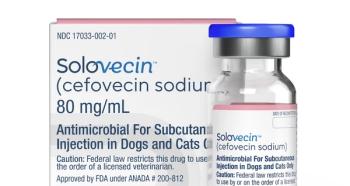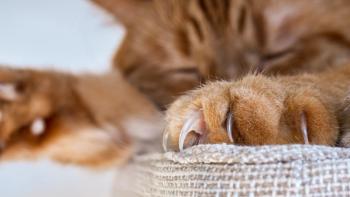
The tenets of urological emergency care in cats
Print out this article and tuck it in your nerdbook for the rainy day when an acutely azotemic cat is carried in your clinic door. You'll be glad you have it.
(Shutterstock.com)The patient is shocky and cold. All the kidney things are messed up on blood work. Potassium is through the roof. Abdominal effusion has creatinine that is double that of the blood. Don't reach for the euthanasia solution yet! Fetch dvm360 conference speaker Alesso Vigani, DVM, PhD, DACVECC, says you can stabilize and save feline urological emergencies.
First, is it a rupture?
After you have placed an intravenous (IV) catheter and drawn blood, Dr. Vigani says that you must rule out rupture or obstruction of the urinary tract in any acute urological emergency, as these patients are very different than urological emergencies due to other conditions, such as pyelonephritis. A rupture also has a different and more favorable diagnosis than many other urological emergencies, so get your diagnosis first!
Some quick facts:
• Approximately 40% of urological emergencies in cats are due to urinary blockage or rupture (unpublished study).
• In almost half of cats that present with acute azotemia, blockage is the cause.
• 11% of cats with pelvic trauma also have lower urinary tract trauma.1
It is imperative to counsel your clients on this risk and advocate an abdominal ultrasonographic examination or an IV contrast study to rule out ruptures or blockages in the lower urinary tract.
A palpable bladder does not exclude a bladder rupture in any way, Dr. Vigani says, so do not rely solely on abdominal palpation for diagnosis.
Dr. Vigani says the only life-threatening circumstances related to obstructive or rupture uropathy are hyperkalemia and shock. If your urological emergency is blockage or a rupture requiring surgical repair, you must stabilize first before anesthetizing the patient. Assess potassium concentrations before you sedate an azotemic patient.
Mortality associated with uroabdomen goes down significantly when you wait to anesthetize until the patient is stabilized and after potassium concentrations are normalized. Dr. Vigani goes as far as to say anesthetizing blocked cats that have an unknown potassium status to unblock them is below the standard of care. “It is true,” he says. “Our patients are a lot more resilient than human beings. If we hit our finger with a hammer, we cry and take ibuprofen like candy for a week. Animals in the wild would chew off a leg in order to escape a trap and survive. However, the resilience of our patients shouldn't justify our intention to their physiologic needs.”
Hyperkalemia?
Everybody knows that in a textbook, hyperkalemia causes bradycardia and abnormal electrocardiography (ECG) readings. Dr. Vigani says the reality is the clinical presentations of hyperkalemic cats and dogs does not correlate at all with the severity of hyperkalemia. Cats can be hyperkalemic and severely tachycardic at the same time due to severe pain, increased sympathetic tone, and hypovolemia and shock. You must check potassium concentrations-heart rate or a normal ECG reading will not be reliable indicators to rule out hyperkalemia.
The first drug to reach for to treat the effects of hyperkalemia is calcium gluconate. Dr. Vigani prefers gluconate over chloride because if the former extravasates it is only mildly irritating. If calcium chloride extravasates, the patient will develop serious tissue injury and can in severe cases lose the leg. Calcium gluconate protects the heart from the effects of hyperkalemia. It raises (makes less negative) the threshold of the action potential of cardiomyocytes, counterbalancing the rising effect on the resting potential by hyperkalemia. However, the beneficial effect of calcium is short-lived (less than 30 minutes). The dose is 100 mg/kg, or 3 to 4 ml/cat (diluted 1:4), IV over 2 minutes, repeated at 30-minute intervals, until the potassium is normalized, to correct bradycardia and ECG changes.
Dextrose and insulin lower potassium concentrations by shifting potassium into cells. If you choose to treat with insulin, always combine it with dextrose, says Dr. Vigani. Lactated Ringer's solution (LRS) is an excellent choice for treating hyperkalemic animals because the potassium contained in LRS is negligible compared with the levels of potassium present in the body. Also, by being a balanced solution, LRS will favor the intracellular shift of potassium inside the cells more effectively than normal saline solution (0.9 NaCl).2
The dosage of regular insulin is 1 U per cat IV, and 2 g of dextrose for each unit of insulin given IV (remember: 4 ml of 50% of dextrose = 2 g, 50% dextrose is 500 mg/ml). Dilute 50% dextrose solution 1:4, and administer over a five-minute period. Insulin can be given as a bolus. Give the dose of dextrose first, then follow with the insulin. Recheck the blood glucose concentration 30 to 45 minutes after to prevent inadvertent hypoglycemia.
Beta2 adrenergic agents such as terbutaline, at a dose of 10 µg/kg intramuscularly (IM), has a synergistic effect with dextrose and insulin to shift potassium intracellularly. Any cat that presents to Dr. Vigani with a potassium concentration over 8 mEq/L gets combination dextrose, insulin and terbutaline treatment. There should be a significant shift in extracellular potassium within 30 minutes, so recheck potassium one hour after treatment. FYI: Unless a patient is severely acidemic with a pH below 7.1, giving bicarbonate will not have any relevant effect on hyperkalemia.
How about fluids?
For most acute urological emergency cases, forced diuresis with fluid therapy is not required and potentially contraindicated, especially in the case of obstruction. Rapidly stabilize the patient if shock is present, consciously replace any losses due to dehydration and vomiting, and then administer maintenance fluids to support normal kidney perfusion and filtration function (glomerular filtration rate).
In cases of uroabdomen, the acute azotemia only relates to reabsorption into circulation from the peritoneum and does not represent a deficit in kidney function. Urea has no significant physiological effect. Even a blood urea nitrogen (BUN) concentration of 200 mg/dl will not harm any organs, Dr. Vigani says. In a patient with traumatic uroabdomen, stabilize the patient, place a urinary catheter, provide adequate analgesia and treat the azotemia medically with maintenance fluid therapy; only then take the patients to surgery to repair the rupture. The one exception is bladder rupture in patients with a history of chronic urinary tract infection (UTI) or evidence of bacteria on abdominal fluid cytology. In these cases, early administration of antibiotics and emergency surgery for abdominal lavage and bladder repair is indicated because of the risk of septic abdomen.
Always place a urinary catheter. No matter where the rupture in the urinary tract is, urine will be reabsorbed through the peritoneum and be filtered again by the kidneys. If you have a urinary catheter in place, whatever enters the bladder will get eliminated.
The priorities with analgesia and sedation in urological emergencies include correcting any electrolyte imbalances, correcting hypovolemia and maintaining core body temperature. Shocky cats have a particularly difficult time maintaining euthermia due to peripheral vasoconstriction. Feline patients that present in shock and are hypotensive and cold have the highest risk of volume overload and pulmonary edema due to vasoconstriction, so be conservative on fluid resuscitation and actively warm them and correct the bradycardia.
Kidney stones?
If you have ever had a kidney stone, then you know that they are horribly, horribly painful. Urethral and ureteral obstructions in cats are painful; opioids are indicated, not only for pain, but also to reduce ureteral or urethral spasm. When sedating a blocked cat, Dr. Vigani says masking down with gas anesthesia is the worst anesthetic choice you could make; IV propofol is the second worst choice in an unstable patient. Once the patient is stabilized, he sedates with low dose ketamine (1 to 2 mg/kg) and midazolam (0.2 mg/kg) to reduce the risk of hypotension and maintain a light plane of anesthesia that complements analgesia that is already on board, enough to unobstruct the urethra.
What about antibiotics? Dr. Vigani says less than 3% of blocked cats have a UTI. Cats with an acute urethral blockage do not need prophylactic antibiotics, but some cats will develop a UTI secondary to urinary catheter placement, so Dr. Vigani recommends submitting urine for culture after you remove the catheter.
In cats, 90% of ureteral stones have calcium in them, so they will be radiopaque. Survey radiographs and ultrasonography have a sensitivity of about 80% in detecting ureteroliths in cats. Combining the findings of both modalities increases the sensitivity to 90%. Medical management of ureteral obstruction is unfortunately fairly ineffective and often unsuccessful, Dr. Vigani says. Even if they pass the stone, the ureteral stricture they develop secondary to the stone will cause them to potentially obstruct again. Counsel your clients accordingly.
References
1. Grey JCJ, Tivers MS. Pelvic fractures and concurrent urinary tract trauma in dogs and cats: a retrospective study, in Proceedings. Association of Veterinary Soft Tissue Surgeons, 2010.
2. Modi MP, Vora KS, Parikh GP, et al. A comparative study of impact of infusion of Ringer's Lactate solution versus normal saline on acid-base balance and serum electrolytes during live related renal transplantation. Saudi J Kidney Dis Transpl 2012;23:135-137.
Dr. Sarah Wooten divides her professional time between small animal practice in Greeley, Colorado; public speaking on associate issues, leadership and client communication; and writing. She enjoys camping with her family, skiing, SCUBA and participating in triathlons.
Newsletter
From exam room tips to practice management insights, get trusted veterinary news delivered straight to your inbox—subscribe to dvm360.






